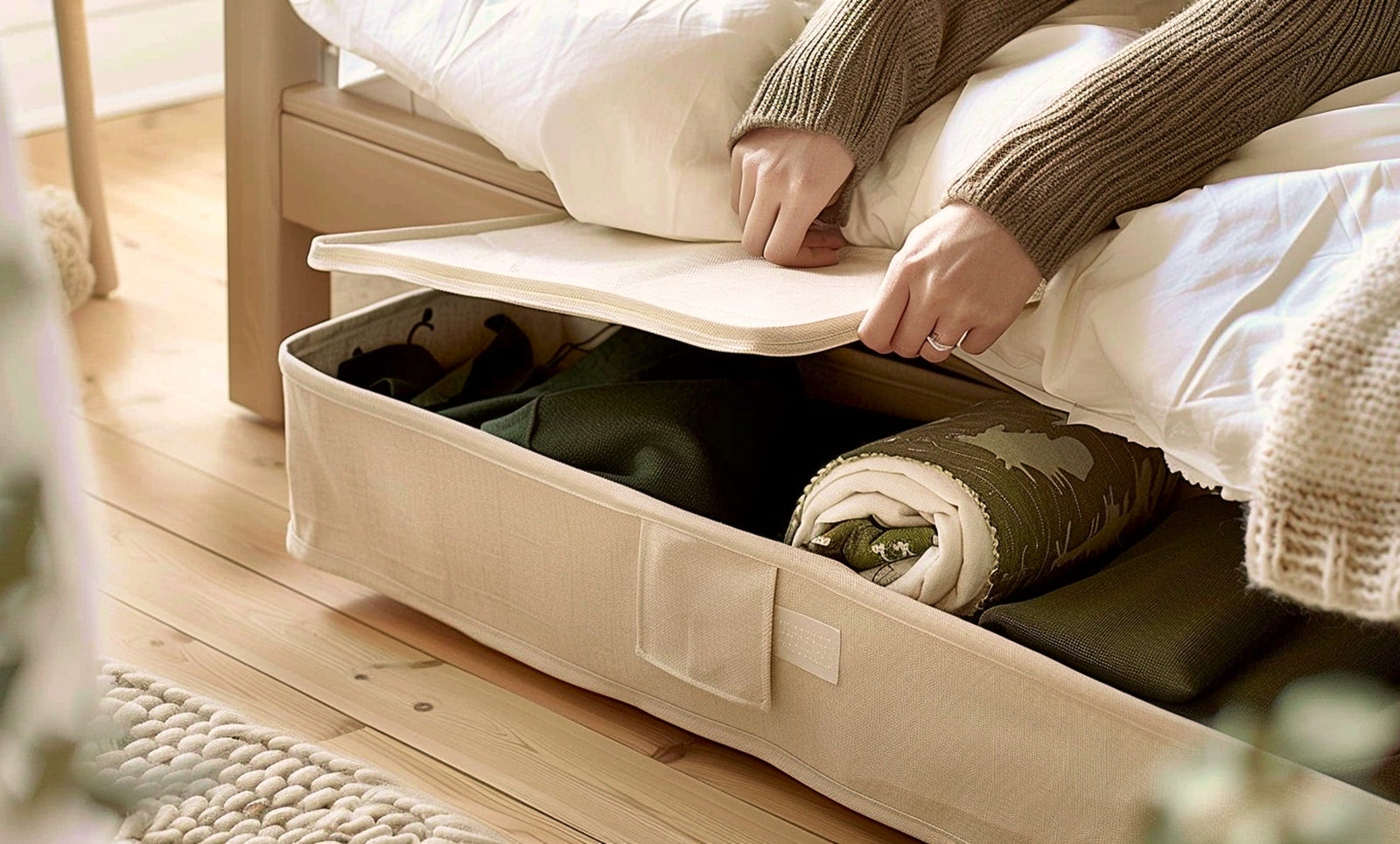How To Store Clothes For Winter + Mothball Alternatives

As the days grow shorter and temperatures begin to cool, it’s time to make room in your closet for sweaters, coats, and boots.
But before you pack summer away, it’s best to prepare everything and store items properly to keep them clean, pest-free, and in wear-ready condition.
To help, we’ve put together this guide on how to store clothes for winter, including how to wash them with human-safe products, storage and organizational tips, and effective mothball alternatives (so you can avoid those harsh, chemical-laden balls while still keeping moths away).
Let’s get started!
How to Prepare Clothes for Winter Storage
Before tossing everything into a bin, let’s take a look at how to prepare your clothes for winter storage.
Decluttering, treating stains, washing, drying, and sorting everything will make unpacking in spring easy and stress-free.
Step 1: Declutter
Cleaning out your summer wardrobe before storing it away may seem daunting, but it doesn’t have to be.
To start, remove all items from shelves and drawers. As you do so, set aside any clothing, shoes, or accessories you haven’t worn in the last year. Donate or re-sell them at a consignment store.
Also, check for items with holes, broken zippers, or missing buttons. Mend the garments, or plan to purge them.
Step 2: Treat Stains, Wash and Dry Clothes
Before storing clothes for winter, we recommend removing stains, washing all items with a natural laundry soap like Branch Basics Laundry or Laundry Detergent, and allowing them to fully dry.
It’s essential to make sure your clothes are free from food, sweat, and urine stains, as these will attract moths and other pests if left.
For stains, pre-treat and then wash. If the stain remains, do not dry it. Instead, repeat the removal process until the stain is lifted. Learn more about everything-natural stain removal in our Stainmaster Guide.
Branch Basics Laundry Detergent powder can be used directly on stains to pre-treat. Just sprinkle on some detergent, spritz with All-Purpose spray, agitate and let sit for 5-10 minutes before washing.
How To Wash Clothes Using Branch Basics
For a normal load, add ¾ scoop of Laundry Detergent powder directly into the drum before adding laundry.
For heavily soiled loads, add 1-2 scoops. Do not overfill front-loading machines. Reducing the amount of clothes in front-loading washing machines is essential to ensure that sufficient water circulates and that the laundry detergent is fully distributed throughout the water.
Overloading can lead to clumps of powder being lodged in clothing, resulting in incomplete cleaning and rinsing.
As always, follow your manufacturer's guidelines.
Or, you can use the Branch Basics Laundry Kit. Just add ¾ capful of Laundry dilution per regular load.
Washing Delicates and Handwash-Only Clothing Using Branch Basics
For delicates or hand-wash only items, follow these instructions:
- Handwash in cold or warm water using a natural laundry soap, like Branch Basics Laundry or Laundry Detergent.
- Gently squeeze out excess water, then place on a bath towel.
- Roll the wet garment up in the towel, pressing firmly to extract as much water as possible.
- Unroll and repeat to remove excess water.
- Lay flat to dry completely before storing.
How to Handwash Silks Using Branch Basics
Silk is a popular summer fabric, but it can be very delicate and require patience when handwashing at home.
Here’s how to handwash silk garments:
- If there’s a stain, wet then spray a small amount of All Purpose*. Gently agitate with a cloth. Rinse to see if the stain has lifted; if not, repeat. Stubborn or set-in stains may require sitting for 15 minutes or more.
- Fill a sink or basin with lukewarm or cool water and ½ teaspoon Branch Basics Concentrate.
- Soak for 15-30 minutes.
- Gently agitate to help remove dirt, odors, and soil.
- Gently rinse by hand under cool or lukewarm water.
- Gently squeeze (do not wring) any excess water.
- Dry by placing the items, one at a time, on a large towel and rolling up like a burrito.
- Press as you go to release the water.
- Dry according to care tag instructions.
*Before washing or treating any stains directly, always test in an inconspicuous place and let sit to ensure colorfastness.
Note: It’s critical that all clothes are completely dry before storing them in containers or garment bags. Any moisture left on clothing can result in musty smells, stains, mold and mildew growth, weakened fabrics, and attract pests like moths.
Learn more in How to Use Branch Basics for Laundry.
Step 3: Sort Clothes and Shoes
Next, sort all clothes and shoes by use, type, size, and fabric. Fold items that can be stacked in storage containers, and hang dresses, suits, and skirts.
Use non-toxic tissue paper and garment bags for extra protection.
Storage Methods for Summer Clothing
Now let’s explore the best types of storage containers and where to store them in your home.
Types of Storage Containers
Store your summer clothing in vacuum-sealed bags to save space, keep garments fresh, and protect them from dust and moisture. Just be sure everything is clean and completely dry!
For delicate fabrics like silks and linen, opt for fabric or mesh garment bags instead. These allow air to circulate and prevent musty odors from forming.
Avoid airtight containers such as plastic bins, as they can trap moisture.
Where to Store Clothing
The best place to store clothes for winter is in a cool, dry, and dark space.
Good options include closets, wardrobes, under the bed, multi-purpose furniture, and shelves.
Only store summer clothing in attics and basements if they are finished and climate-controlled, otherwise they may expose your clothes to dampness and humidity.
Avoid storing in garages, unfinished attics and basements, storage sheds, or anywhere with moisture or direct sunlight.
If space is limited, get creative!
Use flat bins or vacuum-sealed bags for under-bed storage, and choose multi-purpose furniture like storage ottomans or benches that can hold out-of-season clothing.
Consider maximizing vertical spaces with wall-mounted shelves and try tall, narrow wardrobes or dressers.
Organization Tips
Keeping your clothes organized will make unpacking next season so much easier.
Here are a few tips:
- Label everything: Use labels or tags on storage containers and bags so you know what’s inside. Be specific. Write things like “Spring Blouses,” “Summer Dresses,” “High Heel Shoes,” etc., for quick identification.
-
Store by season: Keep seasonal clothing together and clearly labeled. When spring rolls around, you can grab the right containers without digging through off-season items.
- Frequency of use: Consider storing items that you wear most often together. Keep them in an area that’s easy to access, tucking less frequently worn items in the back or on the bottom.
Skip The Mothballs! Natural Mothball Alternatives
You probably know them by their hard-to-miss strong and pungent camphor-like odor designed to ward off moth attacks. But in reality, you’re inhaling naphthalene or paradichlorobenzene, strong chemicals used to make mothballs.
These tiny balls of chemicals are highly toxic to humans and pets, especially babies, children and small pets.
They are often misused, causing harmful fumes to escape and permeate the entire home, and every year, thousands of children and pets accidentally ingest them.[1][2][3]
This is certainly cause for seeking out natural mothball alternatives when you’re storing clothes for winter.
Store Clothes in a Cedar Chest
Natural cedar repels moths and other insects, but do your research. It’s important to understand the pros and cons when using cedar around clothing and in your home.
After carefully researching, consider covering your cedar chest inside and out with a barrier film.[4]
Proper Cleaning and Storage
Moths are attracted to food stains, perspiration and urine odors. Before storing, all garments should be thoroughly cleaned and dried. A moth will not attack clean, stain-free clothing stored in a cool, dry, well-ventilated area.
Plan to store clothing made of wool, fur, or feathers in a tightly sealed container that moths can’t enter. Add tape over zippers, seams and joints to further prevent them from entering.
Store suits, dresses, and other hanging clothes in garment bags, sealed with tape over zippers, seams, joints, and any holes to prevent moths.
Avoid fabric containers, which moths can eat through.
Learn more about moths and proper storage in Mothball Alternatives: Safe Options to Prevent Moths.
Tips For Maintaining Stored Clothes
You shouldn’t just put clothes away and forget about them until next season. Make sure you’re maintaining your items to help keep them fresh and in good condition.
Here are a few tips:
- Check for signs of moths, pests, and moisture issues periodically.
- Keep storage areas clean by dusting and vacuuming. This will deter pests and prevent dust from building up.
- Before spring arrives, remove and place everything in a sunny spot, also known as off-gassing or sunning. This will help air them out and remove any musty, stale odors from storage.
- Air the clothes out in the sun for a few hours to refresh them.
- If they require another day of outgassing, remember to bring clothes in overnight to avoid exposure to dew.
Toss The Toxins With Branch Basics
By now, you should know everything you need to store clothes for winter. All it takes is decluttering, treating stains, washing, fully drying, and storing in the right containers and spaces. It’s really that simple!
When you use Branch Basics to wash and treat stains, you can feel good knowing you’ve taken a significant step to reduce your synthetic chemical exposure and create a healthier home.
If you’re ready to get started, our Premium Starter Kits make it easy.
Available in refillable plastic or glass, this simple, effective, and economical human-safe cleaning system replaces every conventional cleaning product in your home. Just mix our all-in-one Concentrate to make All Purpose, Bathroom, Streak Free, Laundry, and Foaming Wash. You’ll even get a bag of our popular Oxygen Boost.
Looking to dive deeper? Explore our Toss The Toxins Online Course and Wellness Center for more expert tips on detoxifying and safely cleaning your home.
References
Categories

Marilee Nelson
Marilee Nelson is an Environmental Toxins expert who has spent nearly 30 years advocating for the chemically-sensitive and chronically-ill. She is a Board Certified Nutritionist, Certified Bau-Biologist and Bau-Biology Inspector and specializes in Food As Medicine. She has helped thousands of families and individuals identify, heal and recover from toxic exposures and is on a mission to revolutionize the way American families view their health.





